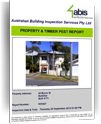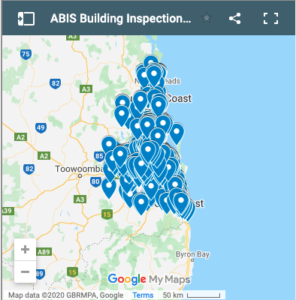Heterotermes ferox is often encountered attacking posts, poles, paling fences, timber decking and flooring of properties wherever weathering and decay are present. Heterotermes ferox is widely distributed throughout Australia, but fortunately does not range far from its small colonies which include a queen, king, soldiers, workers, and reproductives. Soldiers are 3.5 to 7.5mm and have long rectangular heads with no obvious teeth on their prominent and dark mandibles. Both workers and soldiers have slender bodies, move slowly and the soldiers in particular, are not courageous with their peculiar habit of shuffling backwards when confronted.
Although subterranean, Heterotermes ferox does not build mounds, nor does it have extensive gallery systems, but is a multi-nester with very small colonies in the soil, adjacent to stumps, logs on the ground, rotting wood, or even beside the mounds or nests of other species. Heterotermes ferox liberally plasters over its workings, leaving the surface of affected timber with a mottled appearance. Previously, it was thought to be of very little economic significance; however more recent records have shown that it can cause serious damage to sound timber in service.
Heterotermes Summarised
Type: Subterranean
Family: Rhinotermitidae
Sub-Family: Heterotermitinae
Genus:
- ferox
- intermedius
- occiduus paradoxus
- platycephalus validus
- venustus
Identification:
Soldier: 3.5 – 7.5 mm and mandibulate. Long rectangular heads with no obvious teeth on their curved mandibles
Castes:
- Queen
- King
- Soldier
- Worker
- Reproductive
Nest type: Do not build mounds. Small colonies adjacent to stumps, logs on the ground, rotting wood or even beside mounds of other termites.
Significance: Not considered damaging. Attacks occur in fences, decking, posts and poles, where there is some decay or weathering present.
Heterotermes ferox:
Adult: Individuals of the soldier caste of Heterotermes ferox are 4-5 mm long. Their cigar-shaped body is white and not sclerotised. Head: The head is long, rectangular and parallel sided when viewed from above. Mandibles of the soldier caste are elongate, black and sword-like without teeth. A small, indistinct fontanelle is located well behind the anterior margin of the head. Antennae are bead-like (moniliform) and as long as the head. Eyes are small and maybe reduced to a small number of facets. Thorax: Adult termites generally lack wings. The primary reproductive caste have wings for the nuptial flight only. After pairing the king and queen discard their wings leaving scales. The wings of the king and queen are narrow, longer than the body and have few veins. The pronotum is flat without anterior lobes. All legs are similar in termites. The tarsi are 4-segmented. Abdomen: Subterranean termites have 2-segmented cerci at the apex of the abdomen.
Distribution: Heterotermes ferox occurs in southern Queensland, New South Wales, Victoria, South Australia and southern Western Australia. This species is the most commonly encountered species of Heterotermes in southern Queensland.
Pest Status: The subterranean termite typically does not build mounds and populations are not large. The termites often attack poles, fences and posts. They are regarded as minor structural pests causing superficial damage. Heterotermes ferox is sometimes confused with Coptotermes species but the body is more slender. Nests of Heterotermes ferox often occur near other species. The species may be distinguished by workers and soldiers that are slow moving and less aggressive in defence of the colony when compared with other species.




